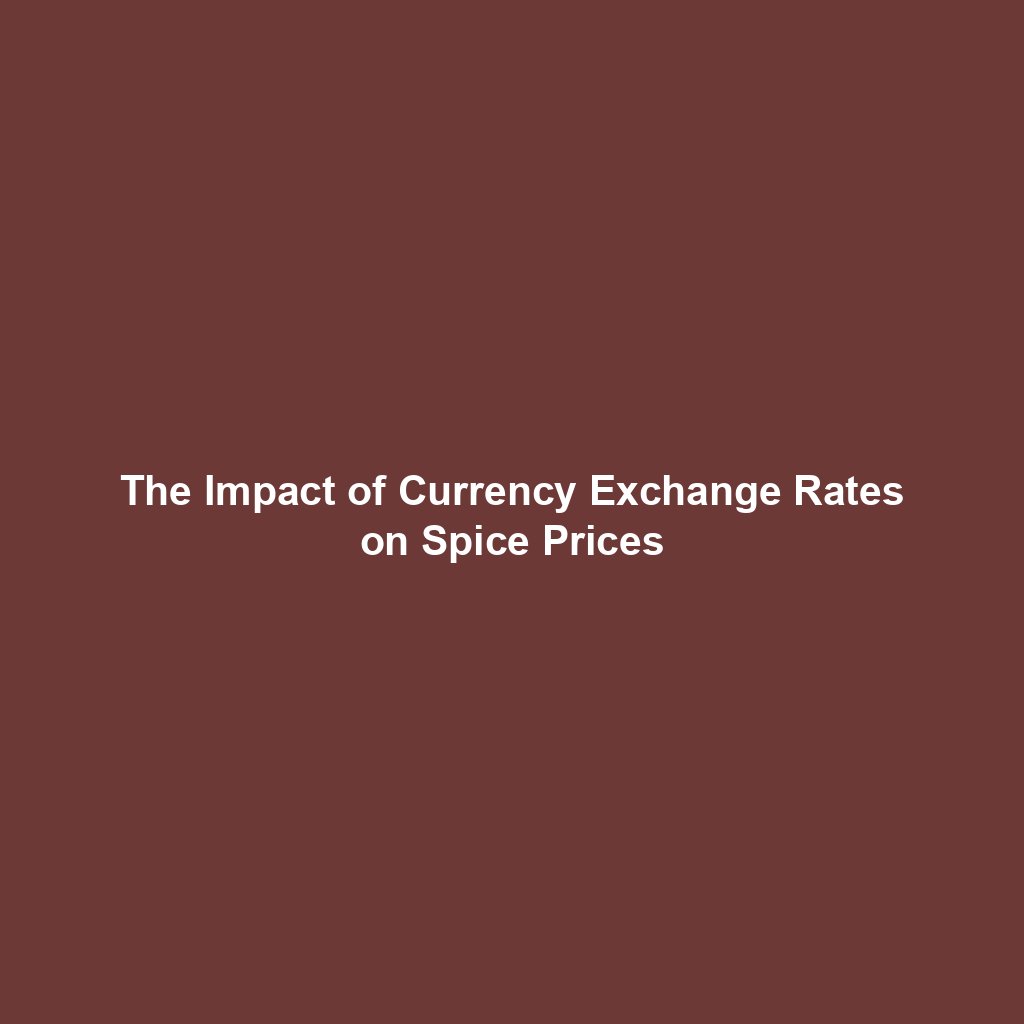
Introduction
The Impact of Currency Exchange Rates on Spice Prices is a multifaceted topic that delves into the intricate relationship between global financial markets and agricultural commodities. Spices, being a significant part of global trade, are influenced by various factors, including currency exchange rates. This article aims to explore how fluctuations in currency values affect the prices of spices, the mechanisms behind these changes, and the broader implications for producers, traders, and consumers.
Chapter 1: Understanding Currency Exchange Rates and Their Influence on Commodity Prices
1.1 The Basics of Currency Exchange Rates
Currency exchange rates are the values at which one currency can be exchanged for another. These rates are determined by various factors, including interest rates, economic stability, and geopolitical events. Exchange rates can be floating, where they fluctuate based on market forces, or fixed, where they are pegged to another currency or a basket of currencies.
1.2 The Role of Currency Exchange Rates in International Trade
In international trade, currency exchange rates play a crucial role. When a country’s currency appreciates, its goods become more expensive for foreign buyers, potentially reducing demand. Conversely, when a currency depreciates, its goods become cheaper for foreign buyers, potentially increasing demand. This dynamic is particularly relevant for agricultural commodities like spices, which are traded globally.
1.3 Mechanisms of Influence on Spice Prices
The prices of spices are influenced by currency exchange rates through several mechanisms:
- Import and Export Costs: When the currency of a spice-exporting country appreciates, the cost of its spices increases for foreign buyers, potentially reducing demand and lowering prices. Conversely, when the currency depreciates, the cost of spices decreases for foreign buyers, potentially increasing demand and raising prices.
- Production Costs: Currency fluctuations can affect the cost of inputs like seeds, fertilizers, and machinery, which are often imported. An appreciating currency can lower input costs, while a depreciating currency can raise them, affecting the overall cost of spice production.
- Speculation and Hedging: Traders and investors often engage in speculation and hedging to manage risks associated with currency fluctuations. These activities can influence spice prices by affecting supply and demand dynamics in the market.
Chapter 2: Case Studies and Real-World Examples
2.1 The Indian Rupee and Black Pepper Prices
India is one of the largest producers and exporters of black pepper. The value of the Indian Rupee (INR) has a significant impact on black pepper prices. For instance, when the INR depreciates against the US Dollar (USD), Indian black pepper becomes cheaper for international buyers, leading to increased demand and higher prices. Conversely, when the INR appreciates, black pepper becomes more expensive for international buyers, reducing demand and lowering prices.
2.2 The Indonesian Rupiah and Clove Prices
Indonesia is a major producer of cloves, a spice widely used in culinary and medicinal applications. The value of the Indonesian Rupiah (IDR) affects clove prices in a similar manner. A depreciating IDR makes Indonesian cloves cheaper for foreign buyers, boosting demand and prices. An appreciating IDR, on the other hand, makes cloves more expensive for foreign buyers, reducing demand and prices.
2.3 The US Dollar and Global Spice Markets
The US Dollar (USD) is the world’s primary reserve currency and is widely used in international trade. Fluctuations in the USD can have a ripple effect on global spice markets. For example, a strong USD can make spices more expensive for buyers using other currencies, potentially reducing demand and prices. Conversely, a weak USD can make spices cheaper for these buyers, increasing demand and prices.
Chapter 3: Broader Implications and Future Outlook
3.1 Implications for Producers
Currency exchange rate fluctuations can have significant implications for spice producers. Producers in countries with depreciating currencies may benefit from increased demand and higher prices for their spices. However, they may also face higher input costs if they rely on imported goods. Producers in countries with appreciating currencies may struggle with reduced demand and lower prices, but they may benefit from lower input costs.
3.2 Implications for Traders and Exporters
Traders and exporters must navigate the complexities of currency exchange rates to maximize profits and minimize risks. They often use financial instruments like futures contracts and options to hedge against currency risks. Understanding the dynamics of currency exchange rates is crucial for making informed trading decisions and managing risks effectively.
3.3 Implications for Consumers
Consumers are also affected by currency exchange rate fluctuations, albeit indirectly. Changes in spice prices can influence the cost of food and other products that use spices as ingredients. In countries with depreciating currencies, consumers may face higher prices for imported spices, while those in countries with appreciating currencies may benefit from lower prices.
3.4 Future Outlook
The future of spice prices will continue to be influenced by currency exchange rates, along with other factors like climate change, technological advancements, and geopolitical events. As global trade becomes increasingly interconnected, understanding the impact of currency exchange rates on spice prices will be essential for producers, traders, and consumers alike.
Conclusion
The Impact of Currency Exchange Rates on Spice Prices is a complex and dynamic topic that highlights the interconnectedness of global financial markets and agricultural commodities. By understanding the mechanisms through which currency fluctuations influence spice prices, stakeholders can make more informed decisions and better navigate the challenges and opportunities in the global spice market.



